The Complete Guide to Structured Interviews
Want to hire top talent and reliably pick the right person for the job? Elevate your hiring process with structured interviews.

Interviews are one of the most common ways that companies evaluate job candidates. They’re also one of the most powerful - if done correctly.
For many employers, the interview is that key stage of the recruitment process that solidifies their decision about who to hire.
All this to say: job interviews are a high-stakes game.
An effective, well-planned, and objective interview process can lead to better decision-making, along with all the benefits that come with hiring great people.
An ineffective, poorly planned, and biased interview process can do the opposite, leading to new hires that are not a good fit and ultimately leading to higher employee turnover and weak performance.
But how can you tell the difference between an ineffective interview process and an effective one? Fortunately, one of the simplest, clearest, and data-backed ways to increase the effectiveness of your interviews is by conducting structured interviews.
Extensive research has demonstrated that structured interviews are two times more predictive of job performance than unstructured interviews. If you could improve your hiring decision-making by 2x, would you?

In this guide, we will discuss everything you need to know to build highly effective structured interviews with confidence.
Table of Contents
Section 1: What are Structured Interviews?
Section 2: What is the Difference Between a Structured Interview and a Traditional Interview?
Section 3: The Benefits of Structured Interviews
Section 4: Common Myths about Structured Interviews
Section 5: How to Implement Structured Interviews
Section 6: Sample Response Scoring Rubric for a Sales Manager Position
Section 7: How to Train Your Staff on Structured Interviews
Section 8: Best Practices for Conducting a Structured Job Interview
Section 9: Tools for Structured Interviews
Section 10: Actions You Can Take Today
SECTION 1
What are Structured Interviews?
Structured interviews ask each candidate the same list of job-relevant questions, in the same order, by the same interviewers, and scores each candidate’s responses with the same pre-determined rating scale. In other words, they have structure built into the way the interview is both conducted and scored.
At its core, a structured interview contains two key features:
- A common set of standardized interview questions measuring job-related qualities
- All candidates are evaluated against a standardized scoring system
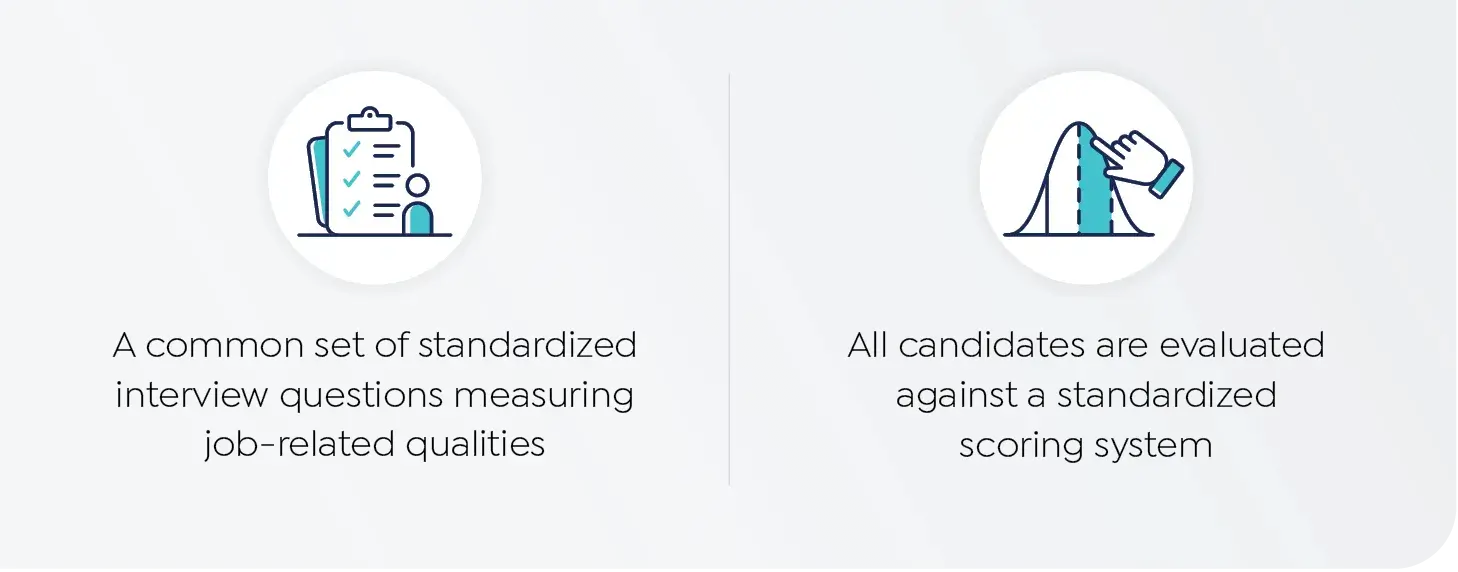
It is this very structure that makes structured interviews so much more effective than unstructured ones. The structure makes it easier to compare candidates fairly based on their job-related skills, leading to a more targeted, less biased, and ultimately more predictive interview.
After all, a structured interview is the single strongest predictor of a new hire’s future job performance.
SECTION 2
What is the Difference Between a Structured Interview and a Traditional Interview?
The main difference between structured and traditional interviews is that a traditional interview is more conversational and lacks specific direction, while a structured interview uses a pre-determined set of job-relevant questions and provides a rating scale to evaluate candidate answers.
Traditional interviews are also known as unstructured interviews.
Unstructured interviews are more conversational, where the goal is to get to know the person and ask questions about the role as you go.
The questions asked may be tailored to the specific candidate based on their background or experience, and because this style of interview is so relaxed, no two interviews for the same job opening are directly comparable.
Let’s take a side-by-side look at these two interview styles:
Unstructured vs. Structured Interviews
Unstructured Interviews
- Interviews are more like free-flowing conversations.
- Only a few (or even no questions) are chosen in advance of each interview, and candidates may not all be given the same questions.
- The job relevancy of each question is not evaluated.
- Candidates aren’t always interviewed by the same evaluators.
- Interviewers aren’t typically given a rubric to score candidate answers.
- Evaluation can happen hours or days after the interview has been conducted.
Structured Interviews
- Interview questions are determined in advance.
- Questions are asked in the same order to each candidate.
- All questions an interviewer asks are relevant to the role.
- The same interviewers review all candidates.
- Applicant responses are evaluated with the same rating scale.
- Evaluation of a candidate happens in real-time.
Unstructured Interviews | Structured Interviews |
| A free-flowing conversation between the interviewers and the candidate. | Interviewer directs the discussion. |
| Interviewer may engage in rapport-building conversation at the start of the interview to “break the ice.” | “Small talk” and candidate questions are put on hold until the interviewers’ assessments are complete. |
| Interviewers have the freedom to ask the questions they prefer to ask. | Pre-defined questions are prepared based on a job analysis. |
| Interviewers can vary the questions from candidate to candidate. | Every candidate is asked the same questions, in the same order. |
| Interviewer may be looking for a good culture fit. | Interviewer is looking for competencies necessary to succeed in the role. |
| Interview questions may cover strengths, weaknesses, work experience, hobbies, and interests. | Interviewers asks behavioral or situational questions that require the candidate to draw upon their experiences to convey competencies. |
| Interviewers may vary for each candidate. | The interviewers involved in the interview are consistent across candidates. |
| What constitutes a good response may be up to each interviewer’s opinion and impression. | Interviewers score each response against an anchored rating scale. Interview guides help each interviewer to score responses objectively against pre-determined criteria. |
The Drawbacks of Unstructured Interviews
Just about every company interviews, but many are using unstructured or semi-structured interviews. This represents a missed opportunity to maximize one of the most valuable touchpoints in the hiring process.
In a recent survey, we found that only 24% of companies were conducting fully structured interviews, which include standardized questions and defined rating scales. 57% were conducting semi-structured interviews, while 17% were conducting conversational, unstructured interviews.
There are a number of drawbacks to not using a structured interviewing process.
First, because the list of questions may vary from candidate to candidate, there tends to be a lot of inconsistency in the information that evaluators gather from each interview.
Plus, traditional interviews often lack specific “grading guides” to evaluate candidate responses, so different interviewers may grade the same response with wildly different expectations.
Additionally, since questions aren’t pre-screened to ensure their relevancy to the role, a lot of informational “noise” gets added into the mix, which can cloud an evaluator’s perception of a candidate’s interview performance.
There are two main consequences that result from these unstructured interviews:
- These practices can introduce bias into your interview process – something that should be minimized as much as possible during hiring.
- Candidates aren’t given the same interview experience, which causes an inconsistency in evaluation, meaning that you could be overlooking the stronger applicant and making poorer hiring decisions.
In the end, though traditional interviews have stayed the more popular interview style over the decades, it’s not the most effective way to interview.
What is a semi-structured interview?
A semi-structured interview is an interview style where there is some sense of consistent structure, but it lacks the reliability and effectiveness of a fully structured interview.
They’re also the most common type of interview that organizations conduct these days, according to recent survey data:
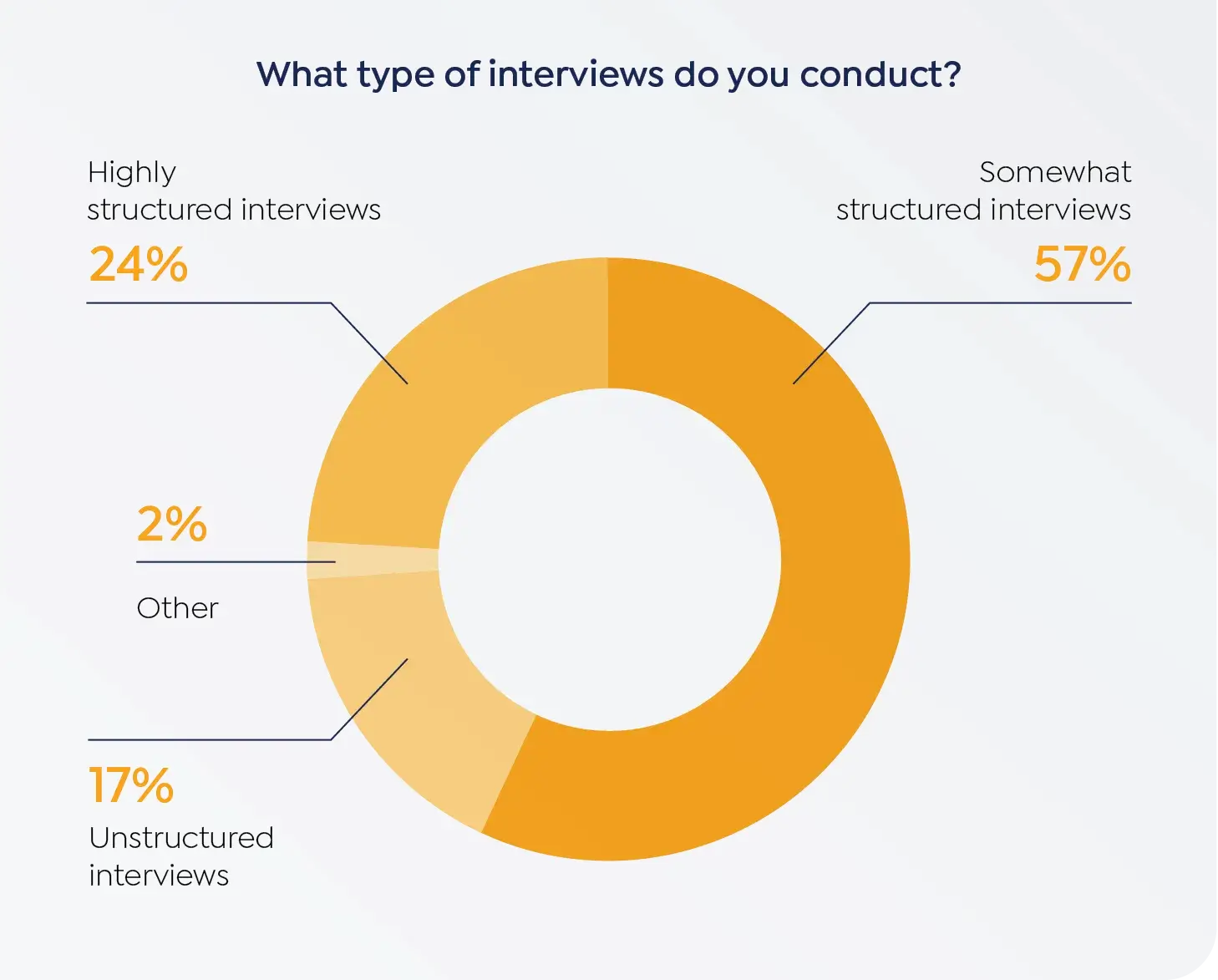
Semi-structured interviews are a step above traditional conversational interviews when it comes to predicting job success, but they’re still no replacement for a true structured interview.
And since the degree of structure can vary so widely, “semi-structured” interviews are often no more predictive of job success than completely unstructured interviews.
If you want your interview process to consistently and successfully find the best person in your applicant pool for the job, fully structured interviews are the best way to achieve it.
SECTION 3
The Benefits of Structured Interviews
Structured interviews take what has often been considered a more subjective part of the hiring process and shape it into one of the most powerful tools in your hiring toolkit.
There are quite a few reasons why structured interviews are twice as predictive of job success as their unstructured cousin.
Structured interviews provide consistent evaluation.
Because every candidate is asked the same questions, in the same order, by the same interviewers, and graded on the same rating scale, it’s easy to directly compare candidates and make a confident decision about who will thrive at your organization.
Structured interviews help reduce bias in the hiring process.
A structured interview is a fair interview.
By cutting back on the small talk until after the assessment part of the interview is completed, interviewers are less likely to be swayed by things that are irrelevant to the job, like a candidate’s hobbies, where they grew up, or other less predictive details.
Featured Resource: Reduce Bias with Structured Interviews
Structured interviews are highly predictive of job performance.
Since the primary goal of a job interview is to identify which candidates will succeed in the role, good interviews must be both predictive and reliable.
Decades of research has established that structured interviews are the single strongest predictor of future job success.
Structured interviews ultimately lead to better hires.
Structured interviews allow evaluators to stay lasered in during an interview.
This style of interview focuses on finding the individual who has the strongest match to the competencies required to succeed after they are hired, not just succeeding during the interview.
Structured interviews are more efficient.
Once a structured interview process is in place, structured interviews actually make the entire interview process faster and more efficient.
When job-related interview questions are designed in advance, and hiring managers are provided with those questions along with standardized rating scales, the entire process moves more smoothly.
Individual hiring managers and interviewers don’t have to spend time coming up with their own questions, and they don’t have to spend too much time thinking about how to evaluate each candidate.
Structured interviews improve the legal defensibility of your hiring process.
Sticking to a set process for interviewing can provide added legal protection.
Employers are responsible for maintaining a fair hiring process, and using structured interviews provides both strong evidence of equitable practices and makes your hiring process more legally defensible if a candidate feels they were unfairly rejected.
Structured interviews can help you achieve your DEI goals.
Structured interviews are so effective at reducing bias that adding them increases the likelihood that candidates from marginalized or minority backgrounds are able to move forward in your hiring process.
For example, by reducing the amount of pre-interview chitchat where an interviewer may ask what school a candidate attended (and form an opinion based on their answer), the impact of a candidate’s pedigree is less likely to be a strong determiner on the hiring outcome.
Structured interviews ensure that you’re focusing the interview on what really matters – how well the candidate can handle the job, regardless of their background.
Structured interviewing can supercharge your hiring process with predictive power, making it more effective at identifying top talent that will succeed on the job.
An overhaul of your current interviewing process now can result in significant positive impacts to your business in the long run.
Featured Resource: 5 Biggest Benefits of Structured Interviews
SECTION 4
Common Myths about Structured Interviews
If structured interviews are so effective, why aren’t more organizations conducting them? Here are a few prevailing myths and misconceptions about structured interviews that we think are worth busting:
MYTH 1:
Candidates dislike structured interviews.
Many interviewers are resistant to adopt structured interviews because they assume that candidates won’t like them, or that they will somehow damage the candidate experience.
This is a common misconception, based on the misunderstanding that a structured interview is going to be inherently more bland or too restrictive compared to a traditional conversational interview.
Busted: Research confidently shows that candidates actually prefer structured interviews over conversational, unstructured interviews.
A recent study from the Lighthouse Research & Advisory found that 7 in 10 candidates prefer interviews where questions don’t vary from candidate to candidate.
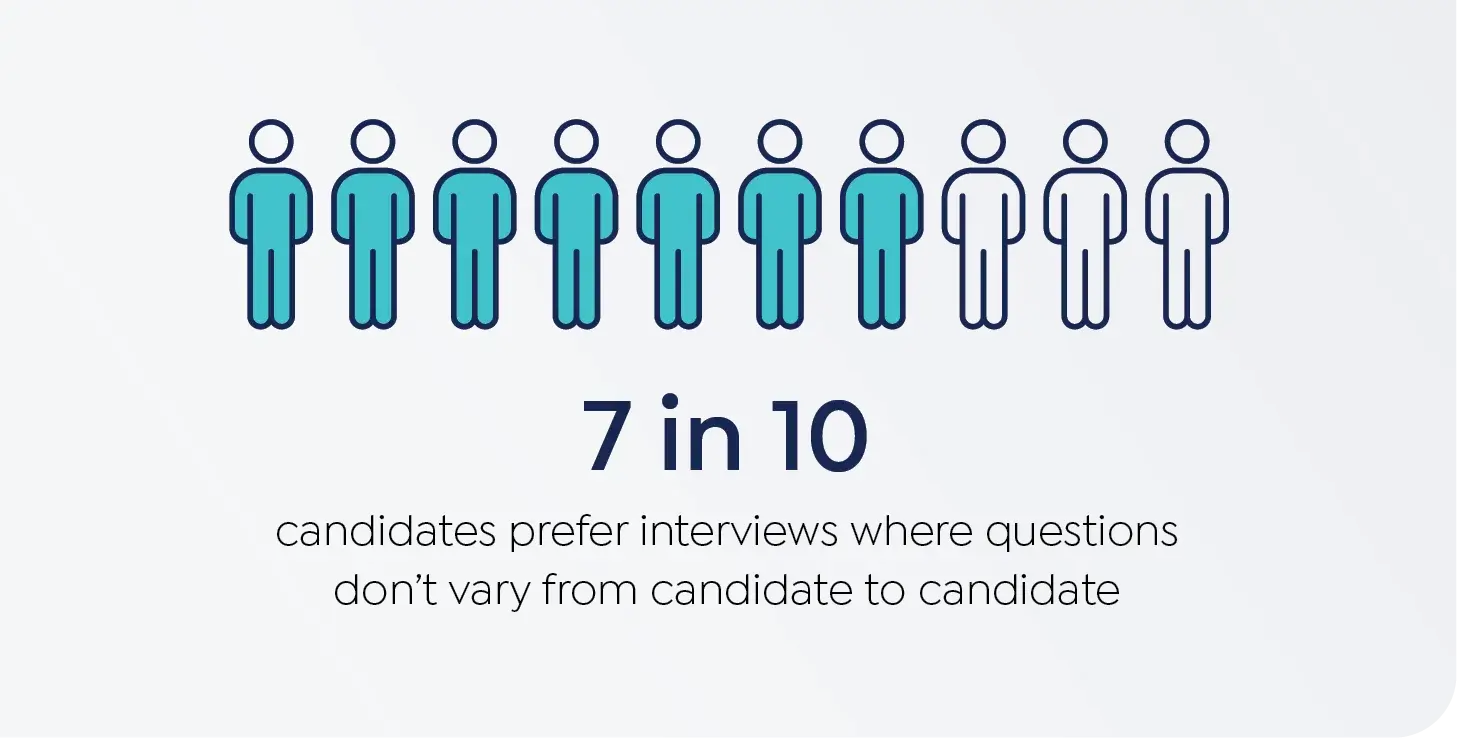
Most job candidates want to be evaluated fairly, on the same footing as everyone else. Candidates understand that by being asked the same questions, they are given equal opportunity to present themselves as the best person for the job.
Structured interviews do just that.
Plus, most candidates won't even notice that an employer is conducting a structured interview. All they will see is an interviewer who is prepared, professional, and focused on job-related questions.
MYTH 2:
Structured interviews are too inflexible for the interviewer to get the information they want.
Many interviewers feel that being required to adhere to a tight structure will limit their ability to ask questions as they would naturally arise.
There’s a common misconception that an interview with structure means it would feel robotic to conduct.
Busted: Interviewing is still a human-centered practice, and we believe it should stay that way. You can formulate questions that highlight your employee experience and work culture, plus you still have the opportunity to inject more personality when you open the floor for candidates to ask their questions.
Structured interviews don’t bar interviewers and candidates from asking more questions. Questions can (and should be encouraged!) be asked after the evaluation portion of the interview is completed.
Candidates are free to ask any questions that they have about life at your organization or the role, and you’re free to get to know them more – without adding potential harmful biases that could impact your hiring decision.
MYTH 3:
Structured interviews lack warmth and make it hard to connect on a personal level with candidates.
Job interviews have often been considered a way to get to know the person behind the resume, and many interviewers have seen them as a tool to determine culture fit or if they will get along with a new hire.
Busted: There’s plenty of opportunity to connect with candidates on a human level during a structured interview.
Even though the questions are all picked for their ability to determine whether a candidate has the job-relevant competencies to succeed on the job, an interview is still your chance to impress the candidate.
You can share information about what it’s like to work at your organization, what the day-to-day of the job is like, and build rapport with candidates.
If you’re still worried that candidates may be put off by structured interviewing techniques, consider notifying them ahead of time so they aren’t left worried about their performance in the interview.
This upfront communication is a great way to keep the candidate engaged while also being direct about what to expect from the interview process.
MYTH 4:
Structured interviews require more research and planning than traditional interviews.
Many interviewers think conducting a structured interview requires so much pre-planning and preparation that they aren’t worth the time and effort to implement.
Busted: While more effort is necessary to get started with structured interviews, that level of effort isn’t required prior to every interview conducted.
Once the question set has been decided, you’ll be sticking with it until there’s a reason to make adjustments (like a new responsibility added to the role you need to ask candidates about).
Structured interviewing allows you to whip out the same reliably predictive question set, making your interview process more efficient in the long term.
For a traditional interview, you’d still be spending time and energy coming up with questions. Plus, you’ll need to either brainstorm questions every time you hire, or just wing it during the interview. All that effort won’t result in the same consistent outcomes when compared with structured interviews.
Once your question set and rating scale has been established, you’re ready to rock and roll! There’s no time wasted trying to find the “right” questions to ask (they’ve already been picked), and responses are evaluated in real-time, so reviewing candidates has never been faster (or more accurate!).
SECTION 5
How to Implement Structured Interviews
Incorporating structured interviews into your organization’s hiring process isn’t (usually) a decision you can make alone. While it’s typically led by a leader in HR or Talent Acquisition, many other stakeholders and managers will need to be on board with the change for there to be wide-spread benefits.
Because there is upfront effort in adopting structured interviews, you will likely need cross-functional buy-in across the talent acquisition team, department heads, and hiring managers to successfully launch structured interviewing at your organization.
If you’re not sure how to begin to get others onboard, make a pros and cons list of how your organization currently conducts interviews.
And start asking yourself questions:
What is your company’s hiring success rate?
How are retention numbers?
What would the return on investment be for improving your hiring process?
Does your organization have DEI goals for the coming year?
What about improved legal defensibility?
These are all strong angles you can leverage when trying to consider the move away from traditional interviews. Set out the key metrics you want to see movement on by implementing structured interviewing.
Different roles in your organization each play a different part in making structured interviewing a reality. Let’s break down some of the additional effort required (and how it pays off in the end).
And remember – the structure created to interview for a role can (and should!) be used whenever that role is being filled.
If you’re interested in a proof-of-concept for structured interviewing, start with the role you either hire most frequently for or have the highest turnover in.
Here's an example of how to set up a structured interview process for a single job:
Structured Interview Process:
- Ensure all stakeholders agree on what a strong candidate looks like for the role.
- Conduct a thorough job analysis and develop relevant questions.
- Create scoring rubrics and rating scales.
- Reduce bias by having multiple interviewers.
- Establish who the interviewers will be.
- Pair structured interviews with other forms of objective candidate assessment.
- Audit the process regularly.
See the steps in more detail below:
STEP 1:
Ensure all stakeholders agree on what a strong candidate looks like for the role.
Everyone needs to be aligned on what qualities a good candidate possesses. This step is critical because it is the crux of the job analysis and the questions that get designed.
Additionally, we’d advise to keep the number of required qualities limited – no more than 5 or 6 – to keep the interview from focusing on less necessary components of the role, or making the interview process take too long.
STEP 2:
Conduct a thorough job analysis and develop relevant questions.
In order to effectively design your structured interview, you need a clear understanding of the job and the specific knowledge, abilities, and skills necessary to succeed.
Start by defining the specific requirements and objectives of the role, and then align with all members of the talent acquisition team on what criteria candidates must meet and how. From here, you can determine the key competencies you want to design your interview to measure.
Once you fully understand the job requirements and what success looks like in the role, you can craft job-relevant questions that get to the heart of a candidate’s abilities. Combine situational and behavioral questions to capture a multi-dimensional view of a person’s competency.
STEP 3:
Create scoring rubrics and rating scales.
Once you have your set of questions, you need to create a standardized scoring rubric so all interviewers can evaluate each candidate’s responses effectively.
Use a 5-point anchored rating scale and provide detailed descriptors for each point on the rating scale to help evaluators know what a good and poor answer looks like. This helps reduce bias by making sure that all evaluators don’t over- or undervalue a particular part of a candidate’s answer.
This rubric also facilitates real-time evaluation, which reduces both bias (it’s harder to be objective about something as more time passes) and the amount of time interviewers need to spend evaluating candidates.
Interviewers should rate each candidate's response with the anchored rating scale before moving on to the next question.
Encourage each interviewer to lock in their individual evaluations before meeting to discuss a candidate. This helps to reduce the chance of groupthink, where people’s opinions can be swayed by others in the group, and reduce the objectivity of the process.
STEP 4:
Reduce bias by having multiple interviewers.
More interviewers results in more data! Scores can be combined and averaged for a quick comparison of which candidate had the strongest interview performance.
Using multiple interviewers makes it less likely that the unintentional biases of one person inform the hiring decision. However, there are two important practices you should adhere to when using more than one interviewer:
- Have the same set of interviewers evaluate each candidate for the role.
- Make sure to limit the amount of conversation interviewers have about a candidate prior to submitting their evaluations.
STEP 5:
Establish who the interviewers will be.
Part of a structured process involves having the same set of interviewers evaluate the same candidates, whenever possible.
This way, when you combine the scores together, the results will be based on the same set of evaluators, leading to a more accurate result and a quick comparison of which candidate had the strongest interview performance.
Using multiple interviewers makes it less likely that the biases of one person will influence the hiring decision.
STEP 6:
Pair structured interviews with other forms of objective candidate assessment.
Structured interviews might be the strongest predictor of future job success, but other objective methods of assessment – like personality and cognitive aptitude tests – will give you additional relevant data to use to find the best candidates in your applicant pool.
STEP 7:
Audit the process regularly.
Measure the success of your interview process by reviewing key metrics regularly. Are you moving the needle on metrics like onboarding time, retention, and engagement? Have you gathered candidate feedback on the interview process?
Even the most well-built machines require frequent fine-tuning to run as best as they possibly can.
Strive for continuous improvement of your process. Done is better than perfect, but perfection is never fully achieved. Keep refining your interview process to better identify top performers and reduce bias.
SECTION 6
Sample Response Scoring Rubric for a Sales Manager Position
How do I create a scoring rubric for a structured interview?
- Specify a core competency of the role you’re hiring for.
- Develop questions that explore a candidate’s capacity to meet that core requirement.
- Determine what a good, thorough answer for each question addresses – this will set the high end of your anchored rating scale.
- Identify what components of an answer separate an excellent from an insufficient response. Be specific! This will fill out the rest of your rating scale for a specific competency.
- Repeat this process for each of your core competencies to build out your scoring rubric for the interview.
Let’s look at an example:
If you’re hiring a sales manager, what qualities are most important to success in the role? The key competencies might include things like personnel management, business acumen, organization and planning, and selling.
When creating your scoring rubric, you’ll use these essential competencies to create a framework for grading the responses to specific questions.
For example, you can ask one behavioral and one situational question on a candidate’s ability to direct and coordinate with other employees.
Behavioral Question: What does your managerial style look like?
Situational Question: Tell me how you have connected your employer’s goals with the individual goals of members of your team.
Then, after the candidate has responded, rate their answer using the 5-point anchored scale for the Directing & Coordinating competency.
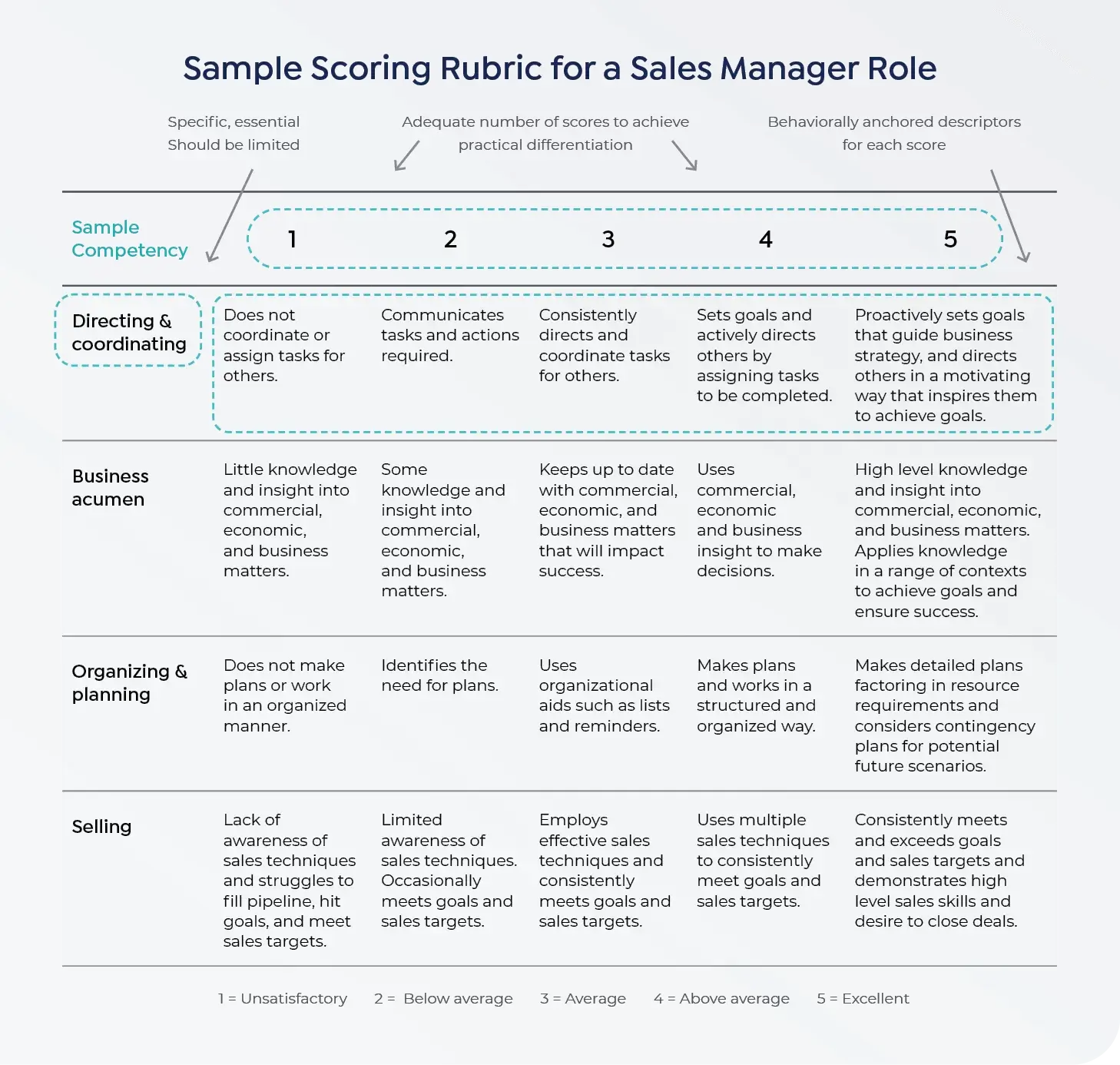
By the end of your interview, you will have a clear understanding of how strongly a candidate matches with the skills required for the role and can use their average scores to quickly compare top candidates - and hire the ones who will be most likely to succeed.
Featured Resource: How to Design Structured Interview Questions
SECTION 7
How to Train Your Staff on Structured Interviews
The benefits of structured interviews won over the higher-ups – now it’s time to get everyone else involved in interviewing comfortable with the new process.
Change management is important here: let everyone know what the expectations will be going forward and how they will need to prepare.
Give hiring managers (along with any other evaluators) the opportunity to ask questions about structured interviewing – you can even send them this guide!
Share the value of structured interviewing with your hiring managers.
Instead of just announcing that change will be happening, share why your organization has decided to make the change. The benefits of conducting structured interviews far outweigh the investment required to set them up.
Interviewing is a lot of work – most hiring managers have to juggle interviews along with the day-to-day duties of their job.
Share how structured interviews will not only make the interview process more streamlined, but how it will speed up the evaluation process and how it will help them find their team’s next star performer.
Create question banks for frequently hired roles first.
Reduce the workload required by starting with the most common role you hire for. This will allow your teams to hit the ground running with structured interviews and start seeing the impact they have.
Conduct a mock structured interview.
Give people a chance to practice! Encourage interviewers to pair off and run through the interview for the role they’re scheduled to conduct.
It allows each evaluator to get used to the flow of the questions, learn how to evaluate responses in real time, and get comfortable with the new interview format.
SECTION 8
Best Practices for Conducting a Structured Job Interview
For any interviewers who are new to structured interviews, here are some best practices to maximize the effectiveness of your interviews.
Structured Interview Best Practices:
- Review your interview materials ahead of the interview.
- Take candidate experience into account.
- Follow the established, standardized questions.
- Use the detailed rating scale for each question’s response.
- Evaluate candidate responses in real time.
- Allow candidates time to ask their own questions.
- Submit your scores before discussing interviews with coworkers.
- Understand your biases.
1. Review your interview materials ahead of the interview.
Before you conduct an interview, it’s a good idea to look over the questions you’ll be asking and check out the rating scale.
2. Take candidate experience into account.
Inform candidates ahead of time about your interview process so they know what to expect. Open and upfront communication is at the core of a positive candidate experience.
Remember: Candidates prefer structured interviews! This style of interviewing grants equal opportunity to prove themselves and candidates recognize that.
3. Follow the established, standardized questions.
Resist the temptation to throw a few “fun” questions into the mix. While these might do a good job at lightening the mood, they ultimately create noise that can prevent you finding the candidate who is the best for the job.
4. Use the detailed rating scale for each question’s response.
You will be provided with a detailed scoring guide to ensure that every evaluator is giving the same weight to each question. This guide also makes evaluation a quick, objective, and easy process.
After each response, give the candidate a quick rating before moving on.
5. Evaluate candidate responses in real time.
Make use of those rating scales! It’s important that evaluators rate a candidate’s response to one question before moving on to the next.
Provide ratings to HR as soon as possible after the interview is over. The candidate’s performance will be fresh in your mind and you’re likely to be most objective about their performance immediately after.
6. Allow candidates time to ask their own questions.
Once the standardized question set has finished and responses have been scored, open the floor to the candidate to ask questions.
This is a great opportunity for you to highlight how great it is to work for your organization.
7. Submit your scores before discussing interviews with coworkers.
Beat the bandwagon! By submitting your completed evaluation prior to conferring with other interviewers, you reduce the risk of their opinions influencing your own (or vice versa).
8. Understand your biases.
Bias is a symptom of the human condition – every person has their own beliefs and experiences that shape the way they see the world and other people.
Do your best to stay objective during interviews – the rating scale provided can help keep your bias in check.
Want to brush up on the types of bias that can impact hiring? Review the 21 most common hiring biases before your next interview.
FEATURED RESOURCE:
Structured Interviewing: Quick Start Guide
What to learn more about how to conduct a structured job interview? Check out our quick start guide here.
SECTION 9
Tools for Structured Interviews
Setting up a structured interview process may sound like a lot of work, but it doesn’t have to be! There are a wide range of software tools that can make it easy to both set up and conduct structured interviews with ease.
Interview Management Tools for Structured Interviews
In this section, we’ll provide an example of how interview tools can assist with structured interviews using Criteria’s Live Interviewing Tool.
At Criteria, we know that structured interviews are one of the single best predictors of job performance, and yet many companies are still resistant to adopting a structured process.
To learn more about why, we surveyed hiring professionals and found that some of the biggest hurdles preventing people from conducting fully structured interviews include things like:
- Developing the process
- Defining the interview questions
- Defining the evaluation rubrics
- Getting hiring managers to comply, and
- Collecting and analyzing the results from multiple evaluators.
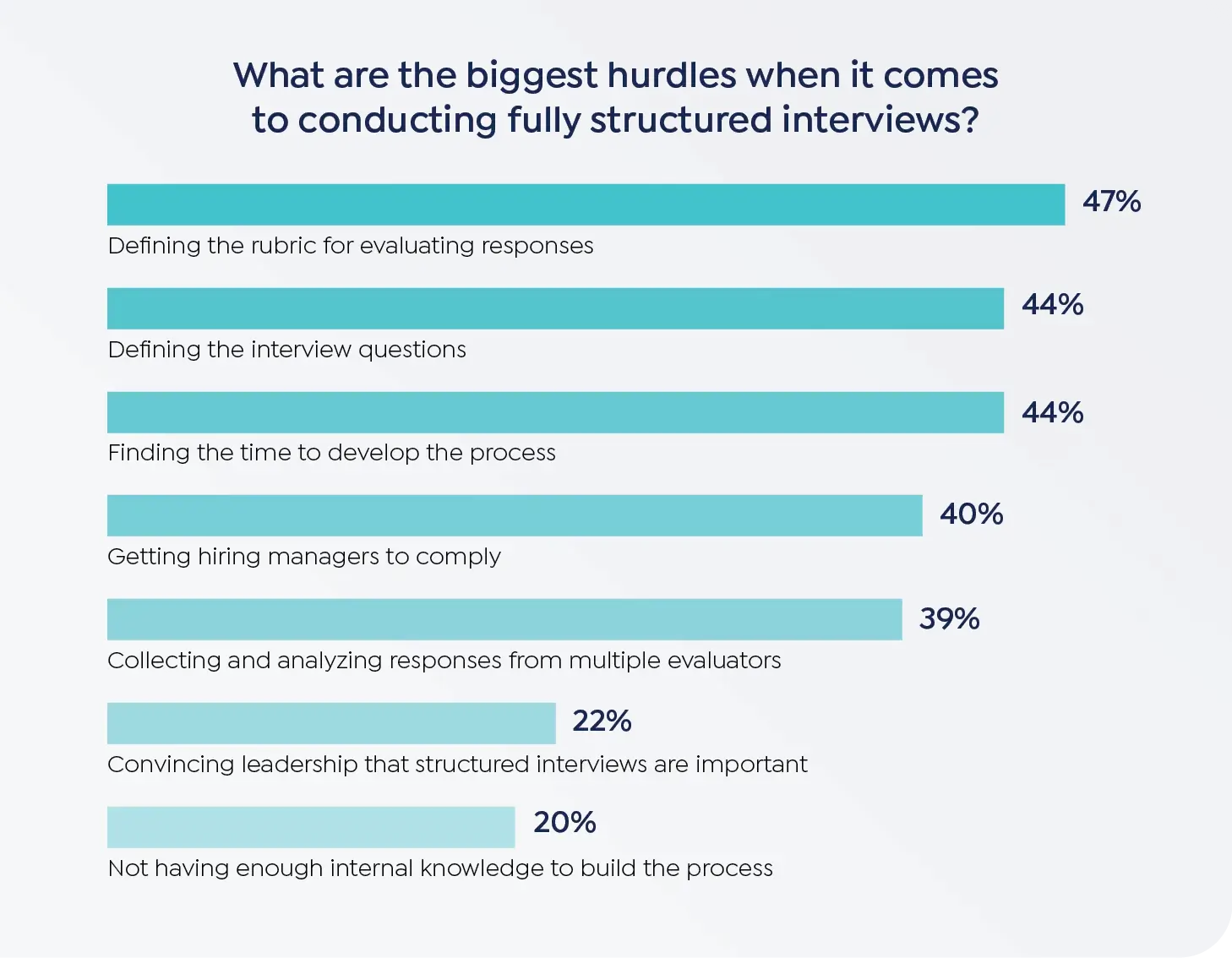
Based on this data, Criteria’s team of engineers and I/O psychologists built an interviewing tool designed to tackle some of the biggest hurdles that are getting in the way of companies conducting structured interviews.
The tool, called Live Interviewing, is a flexible interview assistant that you can use alongside any live interview, whether that interview is in-person, over video, or over the phone. It relies on technology to make the entire structured interviewing process easier for your whole team.
For example, it makes it easy to:
- Adopt: the tool is device-agnostic and can be used for any live interview.
- Develop questions: you can choose questions from a pre-built library of interview questions or create your own to focus on your company’s job-related competencies.
- Develop evaluation rubrics: quickly set up scoring rubrics that all your interviewers can use.
- Training hiring managers: hiring managers get access to interview guides, where they can see all the questions and access the scoring rubrics that they can fill out in real time.
- Collect and analyze the results: the platform combines all the results into one system of record, where you can view a final, objective score for each candidate and make more confident final decisions.
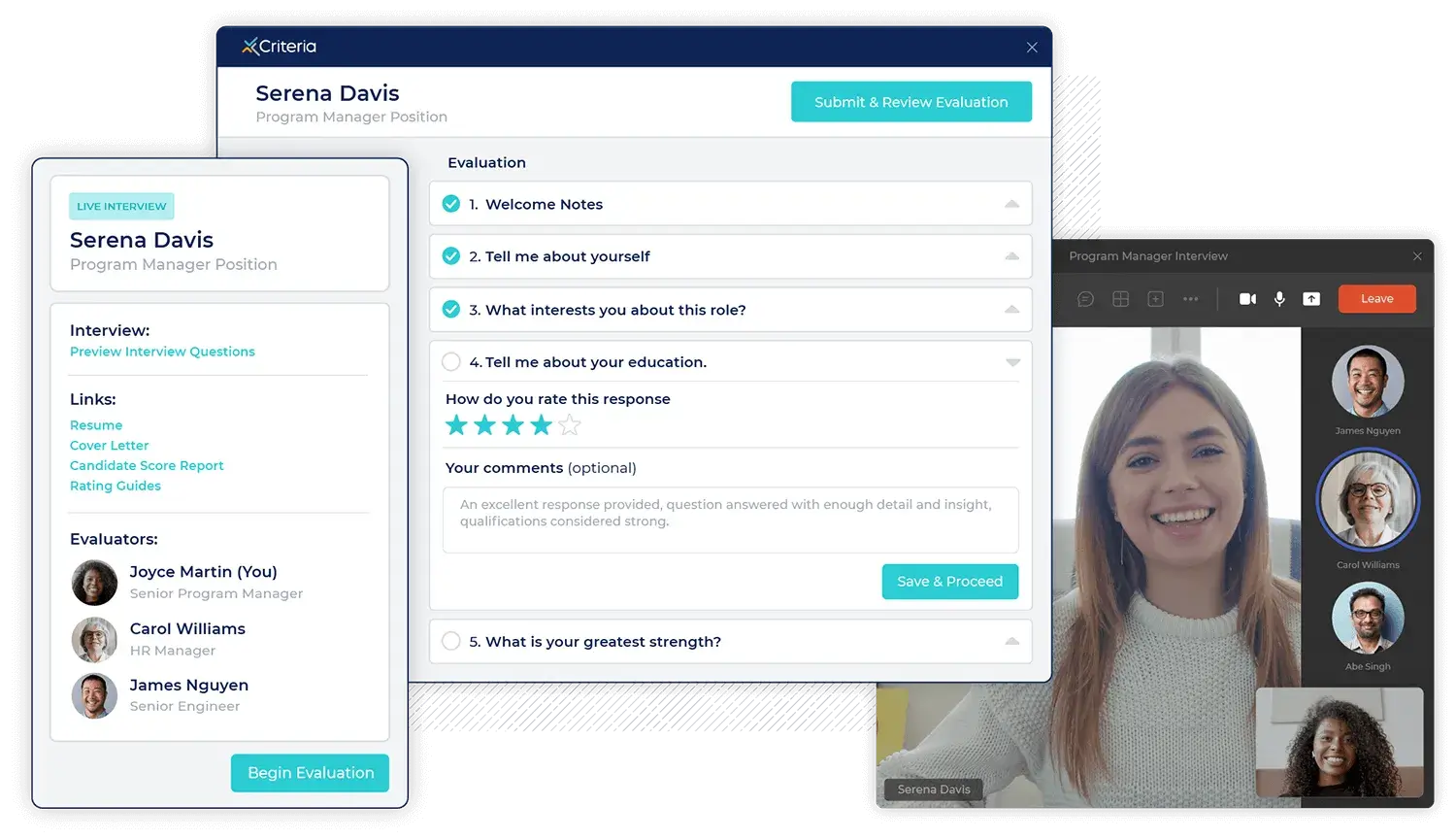
This is just one example of a tool you can use to better enable a structured process. But it’s a useful reminder that technology can provide the guiderails needed to ensure that your team conducts the most effective, predictive interviews.
Tools for Asynchronous, Pre-recorded Structured Interviews
Asynchronous, or pre-recorded, video interviewing platforms allow you to pre-record questions for candidates to answer on their own time.
They’re a perfect tool for structured interviews because all you need to do is upload the job-relevant questions selected during the job analysis and you’re good to go!
Many asynchronous tools even allow for real-time rating of recorded candidate responses to each question, making evaluation a breeze.
An asynchronous interview tool allows you to standardize your virtual interview process with ease. Despite the convenience of tools like Zoom or Teams to conduct a virtual interview, they aren’t designed to facilitate a great interview experience.
Using a dedicated video interview tool will unlock features that both standardize your interview process (a critical component of any structured interview) and even reduce the risk of bias influencing your hiring decisions.
This type of virtual interviewing tool automatically locks in the structure of the interview: every candidate is given the same prompts to respond to in the same order, for the same amount of time.
When evaluators go to review a candidate’s interview, the scoring rubric is baked into the UI, making evaluation a breeze.
For example, Criteria’s asynchronous Video Interviewing tool enables you to:
- Choose from a pre-filmed library of standardized questions
- Easily set up standardized scoring rubrics for each question
- Create immersive, scenario-based assessments and situational judgment tests
- Provide real-life job previews and scenarios
- Collect responses in one system of record
- Collaborate and share feedback with other interviewers
- Reduce bias and increase diversity with features that disguise names and voices
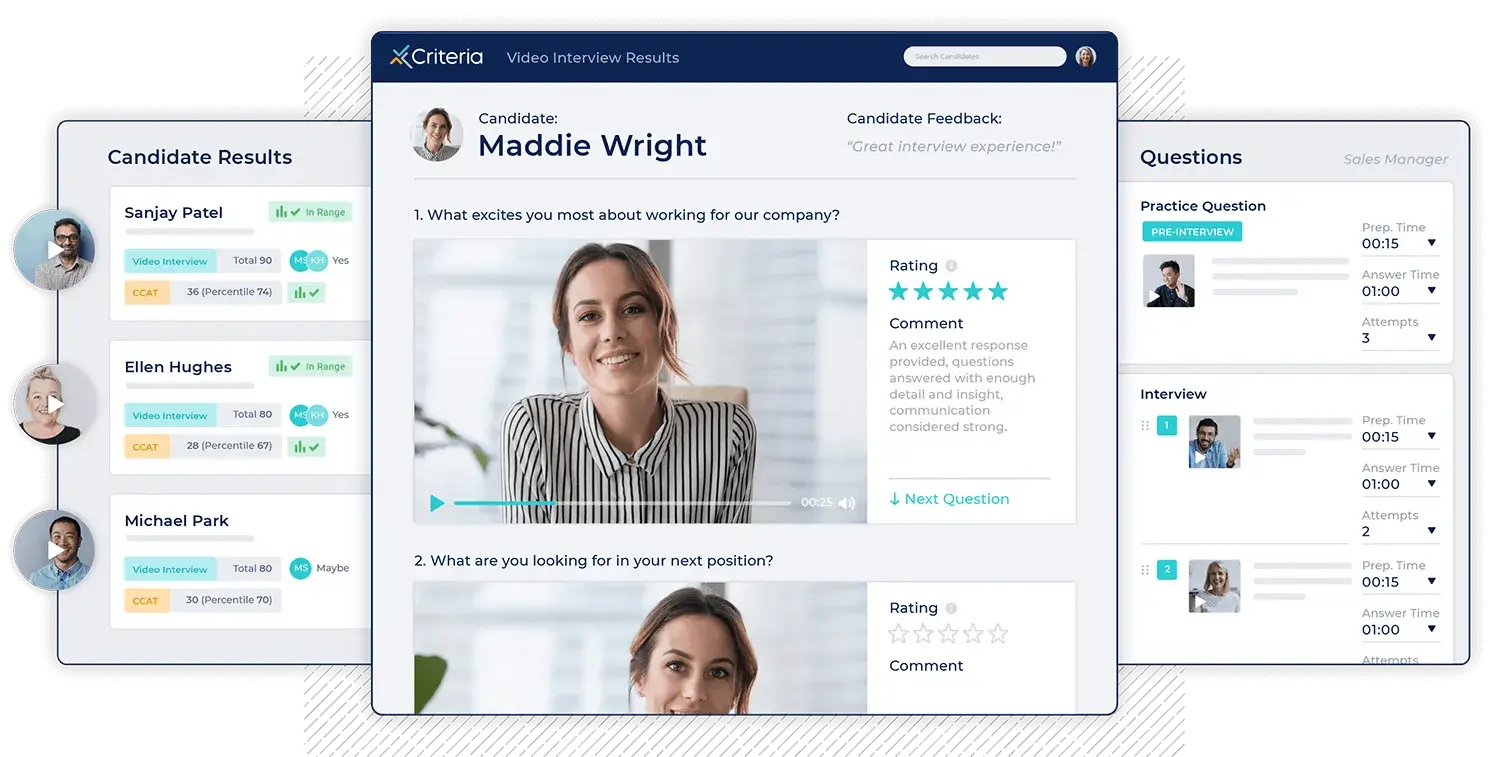
Asynchronous video interviewing tools are convenient for candidates and evaluators alike, allowing both sides of the table to participate in the interview at a time and place that works best for them.
The convenience of asynchronous video interviewing is unparalleled for evaluators. Several candidates can be reviewed and evaluated in a fraction of the time it takes to conduct a single interview.
Applicant Tracking Systems
You can use your ATS to keep track of interview performance and then directly compare candidates interview scores with one another.
These systems will help you manage the data your new interview process produces and make sure it stays visible to your internal decision makers.
SECTION 10
Actions You Can Take Today
Even if you can’t make the switch to fully structured interviews at-scale yet, what incremental changes can you make this quarter to have a positive impact on your interview process?
If you’re interested in structured interviewing but still not sure where to begin, that’s okay!
Here are some simple ways you can add structure to your interview process and start seeing the benefits for your organization.
Review your current interview process.
Where is your interview process right now? And where do you want it to be?
Simple changes, like sending all evaluators an email with a set of suggested questions in advance of the interview, can help make a difference.
Start small.
It doesn’t have to be all-or-nothing.
Start with the role you interview for the most, or just encourage hiring managers to use the same questions with each candidate. You can use this single role as a test case for the widespread adoption of structured interviewing.
Remember that candidates care most about fairness.
Don’t worry that structured interviews will harm the candidate experience.
Candidates prefer them over traditional interviews because they give every candidate the same opportunity to demonstrate their strengths.
Once structured interviews have been implemented, they actually speed up your candidate evaluation process.
Structured interviews can help you make more accurate hiring decisions quicker, getting your top talent out of the job market (and competitor’s hiring funnels) faster.
Lean on technology.
Finding the right tool makes it easy to get up and running with structured interviewing. They take the guesswork out of the process and enable you to quickly adjust your hiring procedure.
Choose from a robust collection of interview questions to make a job-relevant and effective interview. Use pre-recorded interview questions ensure every candidate is given the identical opportunity to prove themselves.
Submit evaluations in real time to avoid biases. Dedicated structured interviewing tech allows you to make the switch with ease.
Want to learn more about Criteria’s interviewing tools? Contact us today to learn more about the affordable and effective tools at your disposal.
Final Thoughts
Structured interviews are one of the simplest and most powerful ways that organizations can start making better hiring decisions.
They reduce hiring bias, improve candidate experience, and improve hiring outcomes, which in turn leads to better company performance, higher employee retention, and all the incredible benefits that come along with that.
While there is effort involved in making the jump to fully structured interviews, adopting them as a part of your hiring process will result in a fairer, more predictive, and more efficient hiring process that allows you to identify top talent.
